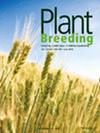Identification of QTL Associated With Luteolin Content in Peanut (Arachis hypogaea L.) Shells
IF 1.8
4区 农林科学
Q2 AGRONOMY
引用次数: 0
Abstract
Investigating the inheritance and genetic variation of luteolin content in peanut shells is pivotal for developing improved cultivars with high luteolin content. In this study, we developed a genetic map spanning 976.8 cM using 115 highly advanced recombinant inbred lines (RILs) and the Axiom_Arachis array containing 58K single‐nucleotide polymorphisms (SNPs). Quantitative trait locus (QTL) analysis was then performed using phenotype data from 2‐year field trials. From these analyses, we identified three significant QTLs with 4.1%–11.7% phenotypic variation explained (PVE) for luteolin content in peanut shells. We further identified five candidate genes with putative functions suggesting possible involvement in plant flavonoid and terpenoid biosynthetic pathways in peanut luteolin biosynthesis. Additionally, two new peanut inbreeding lines with high luteolin and oleic acid levels were selected and are expected to be used as multifunctional genomic backgrounds for future breeding and research programs. The information on the QTL regions and candidate genes from the present study could be very useful for developing new peanut cultivars with high luteolin content and for identifying the genetic/genomic determinants of luteolin content in peanut shells.花生(Arachis hypogaea L.)果壳中叶黄素含量相关 QTL 的鉴定
研究花生壳中木犀草素含量的遗传和遗传变异对于改良高木犀草素含量的栽培品种至关重要。在这项研究中,我们利用 115 个高度先进的重组近交系(RILs)和包含 58K 个单核苷酸多态性(SNPs)的 Axiom_Arachis 阵列绘制了一幅跨度为 976.8 cM 的遗传图谱。然后利用两年田间试验的表型数据进行了定量性状位点(QTL)分析。通过这些分析,我们确定了花生壳中叶黄素含量的三个显著 QTL,其表型变异解释率(PVE)为 4.1%-11.7%。我们进一步确定了五个具有推测功能的候选基因,表明它们可能参与了花生叶黄素的生物合成过程中植物黄酮类和萜类化合物的生物合成途径。此外,我们还选育出了两个具有高木犀草素和高油酸含量的花生近交系,它们有望作为多功能基因组背景用于未来的育种和研究计划。本研究中有关 QTL 区域和候选基因的信息对于培育高木犀草素含量的花生新品种以及确定花生壳中木犀草素含量的遗传/基因组决定因素非常有用。
本文章由计算机程序翻译,如有差异,请以英文原文为准。
求助全文
约1分钟内获得全文
求助全文
来源期刊

Plant Breeding
农林科学-农艺学
CiteScore
4.40
自引率
5.00%
发文量
74
审稿时长
3.0 months
期刊介绍:
PLANT BREEDING publishes full-length original manuscripts and review articles on all aspects of plant improvement, breeding methodologies, and genetics to include qualitative and quantitative inheritance and genomics of major crop species. PLANT BREEDING provides readers with cutting-edge information on use of molecular techniques and genomics as they relate to improving gain from selection. Since its subject matter embraces all aspects of crop improvement, its content is sought after by both industry and academia. Fields of interest: Genetics of cultivated plants as well as research in practical plant breeding.
 求助内容:
求助内容: 应助结果提醒方式:
应助结果提醒方式:


